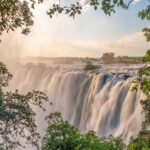My journey to Botswana to track wild cheetahs was one of those rich, layered experiences that stays with you long after the safari vehicle stops. I learnt that there is the surface sparkle of “see the cheetahs!” and then there is the deeper truth of what really happens behind the scenes.
If you’re seeking a wild adventure that’s meaningful and grounded, then this topic is especially relevant. It’s not just about spotting the fastest land animal on Earth; it’s also about where it lives, what problems it has, and how you act as a thoughtful visitor.
So, let’s explore what you need to know about cheetah tracking in Botswana.
Wild Cheetah Tracking in Botswana

Tracking wild cheetahs in Botswana isn’t merely ticking off a bucket-list animal. The country is home to a significant chunk of the world’s wild cheetah population, which is roughly estimated at 1,700 individuals, or about 25 % of the global population.
These cats are vulnerable. They face habitat loss, prey decline, and human‐wildlife conflict. When you engage in a safari to track them, you’re entering landscapes where conservation and tourism intersect.
That has personal significance for someone like me who enjoys exploring legacy, purpose, and meaningful travel.
Seeing a cheetah move through grass or sit on a termite mound makes you think about how strong, adaptable, and connected you are.
The Reality Behind the Cheetah Tracking Safari Hype in Botswana

Sightings Aren’t Guaranteed
A lot of safari companies say that you will see cheetahs when you go on a cheetah tracking trip, but the truth is more complicated. These cats cover a lot of ground, and they stalk and hunt in places where it’s hard to see them.
A friend of mine told me that even in Botswana, where there are a lot of cheetahs, it’s still hard to see them.
So here’s what I discovered in the field: you might see cheetahs. You might not. Some days you’ll drive for hours and hardly see anything move. That doesn’t make the experience any less real; it just makes it real.
So I saw this as a perfect opportunity to shift from “I must get the photo” to “I’m present in the wilderness”.
The Terrain & Behaviour Make Tracking Hard
These cats prefer open country where they can sprint but also rely on stealth. In Botswana, you’ll be in a variety of habitats, such as the grasslands of the Okavango, the scrub of the Kalahari, and the termite-mound lookout points.
Guides look for tracks, signs, and behavioural cues that show where prey is, and yes, even termite mounds.
One thing that isn’t often talked about is that cheetahs don’t spend as much time in dramatic chases as you might think. They might sit, lie low, or wait. They live in the same area as hyenas, lions, and other animals that could ruin their kills.
So, if you push a story of “spectacular chase every time”, you’ll be let down if you don’t see it.
Conservation Reality
More than 70 % of Botswana’s cheetahs live outside protected areas, in working farmlands, communal grazing zones and landscapes shared with people.
That means their lives, habits and survival are deeply tied to human activity, land use decisions, and conservation programmes.
Your safari stay is part of a bigger picture. You’re not just a photo op; you’re part of a landscape with real stakes.
READ ALSO: Epic Gorilla Trekking in Uganda vs Rwanda: A Powerful Wildlife Experience
What Tour Agencies Might Not Tell You

Cheetah Tracking in Botswana is Not Just About the View
A lot of ads say “see the cheetah,” but they don’t talk about how part of the experience is waiting, watching, and being very still. For some tourists, this can be a gift because it gives them time to think and slows things down. But it also means you might not see as much action as you think.
Logistics Are More Complex Than You Think
Remote camps. Charter flights. Light-aircraft transfers. Weight limits on luggage. Variable connectivity.
These logistics are very important for cheetah tracking in Botswana. It’s plush and remote. And yes, that means some discomfort if you’re expecting full hotel-style service.
Your Comfort & Physical Preparedness Matter
Cheetah tracking in Botswana may involve early starts, bumpy vehicles, long hours outside, and very open landscapes. I found that being comfortable in my body, with stamina and readiness for modest physical challenge, helped me enjoy the experience rather than struggle through it.
The “Kill” Moment Is Wild and Raw
If you hope to see a cheetah hunting, know this: you might witness a kill, but you might also witness a chase that fails or the aftermath of prey stolen by hyenas. Nature is raw.
Honestly, the cheetah safari experience is not always glamorous. If you’re travelling to rejuvenate, be emotionally prepared for moments that stir unexpected feelings.
You Contribute to Conservation
Your visit supports the local economy, the wildlife reserve and its guides. Organisations like Cheetah Conservation Botswana (CCB) rely on partnerships and tourism funds.
But check how your chosen camp operates: Are they part of community initiatives? Do they track their conservation impact? As a thoughtful traveller who cares about legacy, this was very important to me.
READ ALSO: Tracking Desert Elephants in Namibia: A Once-in-a-Lifetime Wildlife Experience
Practical Tips for a Well-Informed Cheetah Tracking Safari
Choose Your Regions Wisely
If you’re targeting cheetahs, regions to consider include the open grasslands of Botswana’s Moremi Game Reserve and Kgalagadi Transfrontier Park. Private conservancies with fewer vehicles and experienced trackers uplift your chances (and comfort).
Work With Experienced Guide & Tracker Teams
Guides’ ability to read tracks, guess where people are going, and find their way around the land is what makes the difference. Ask: Does the camp have a driver and a dedicated tracker? Are there fewer people in the group? Are there early departure windows?
Schedule Time With Realistic Expectations
Instead of hoping to see dramatic cheetahs every day, try to “spend time in the wilderness, track wild cats, and take in nature.” That shift in mindset makes the experience more enjoyable and less stressful.
For a traveller like me, it makes sense: thriving isn’t just about the big bursts; it’s also about being present and strong.
Packing & Health Considerations
- Neutral-colour clothes, layers for cool mornings, and sun protection.
- Lightweight soft luggage (many charter flights).
- Binoculars, a camera, and spare memory cards.
- Good walking shoes. Even if you don’t trek far, vehicle rides can jostle.
- Malaria risk: be sure to consult your doctor ahead of time.
- Consider your physical comfort: morning drives start early, and evening drives may be cool.
Respect Wildlife & Community
- Always follow your guide’s instructions on distance, behaviour and respect.
- Ask about camp’s contribution to local communities and conservation efforts.
- Remember your being there matters: you’re entering a habitat, not a theme park.
Personal Reflection
I got out of our 4×4 in the Okavango region one morning at dawn for cheetah tracking, being very quiet and holding up my binoculars. Our tracker saw a lone cheetah calmly sitting on a termite mound, looking out over the golden grasses.
We watched for a long time. No running after. No sudden burst of speed. It was simply the still beauty and presence that captivated me.
Back at camp, I reflected on my own life. The cheetah, sleek and alert, made me remember that speed is great, but so is a steady, thoughtful pace. A cheetah doesn’t just run to stay alive; it also scans, waits, stays alert, and makes decisions.
When I got home, I told my friends, “Don’t plan on seeing the cheetah just to tick it off your list.” Be still, open, and ready.
And this is what I love about travel. It doesn’t just regenerate. It makes you think, change, and go in a new direction.
Final Thoughts
If you’re considering wild cheetahs tracking in Botswana, do so with your eyes open. It’s an adventure that offers more than any trophy snapshot. It’s a lesson in being patient and connected to animals, land, guides, and yourself.
You might leave with a cheetah photo. You might not. What you will take away is memory: the silent grass, the waiting, the moment of recognition when the light catches the cat’s spots. And maybe, just maybe, you’ll learn something new about yourself, about the speed, the presence, and your life’s purpose.
So go. With curiosity. With respect. With realistic expectations. And let Botswana’s wild cats show you more than speed: they’ll show you stillness in motion, readiness in quiet, and purpose in being.
I wish you the kind of safari that changes more than your camera roll.






